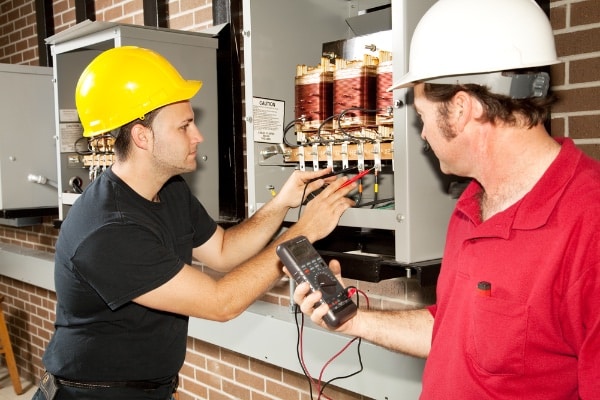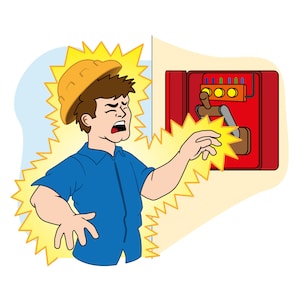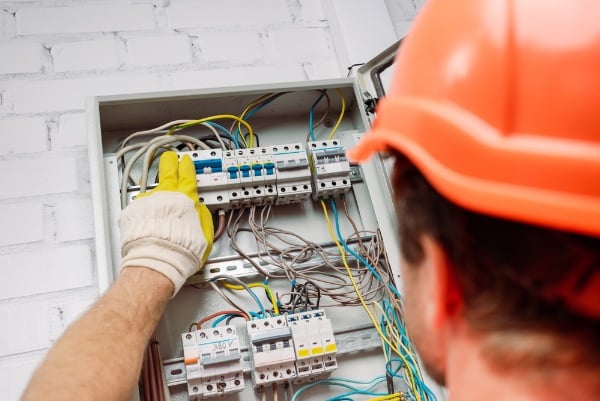What Should Be Included in Electrical Safety Training?

All employees working in a facility with electrical equipment should undergo electrical safety training, even if their jobs do not directly involve working with energized parts or equipment. Electricity in all forms can cause serious injury or even death.
Electrical safety tips and tricks can help employees avoid electrical hazards and maintain a safe work environment. This information and our more comprehensive electrical safety training video will help keep your employees safe when working with electricity.
Here are eight elements to include in electrical safety training for employees.
1. Electrical Safety Fundamentals
Workplace electrical safety training should begin by covering electricity basics.
Electricians must have a thorough grasp of the dangers involved in electrical work and the importance of de-energizing equipment. Even unqualified employees need at least a bare-bones understanding of how electricity works if there’s a chance they might be exposed to electrical hazards.
Use the following five guidelines to help employees stay safe when working on electrical systems.
- Disconnect electrical cords completely. Before working on electrical equipment, removing the power source is essential to reduce the risk of electrocution. This could mean unplugging the appliance or shutting off the circuit breaker.
- Ensure the cords can’t be reconnected. Use lockout tagout procedures and/or a ground fault circuit interrupter to ensure the circuits can’t be flipped back on while you’re working and that nobody accidentally reconnects the plug.
- Examine the voltage. The equipment should be fully de-energized with no presence of electrical voltage. Never work on energized equipment.
- Ground the installation. This involves short-circuiting the installation so that if the electrical current is somehow restored, the discharge won’t harm nearby workers.
- Secure the area. Use ropes, signage, and other ways of cordoning off the area to ensure unqualified employees know to stay away.
These “Five Golden Rules of Electrical Safety” comprise the backbone of electrical safety training for most workplaces. Ensure all employees understand these principles before moving on to more specific hazards.

2. Qualified Persons vs. Unqualified Persons
In addition to covering electricity basics, your workplace electrical safety training should educate all workers on the difference between qualified and unqualified persons.
As an example, professional electricians are considered qualified employees, while custodial staff and office workers are considered unqualified employees.
This distinction also covers workers who have not yet undergone appropriate electrical safety training. An electrician who is new to the company should be considered an unqualified employee until they are familiar with the specific training protocols and emergency procedures in the workplace.
To ensure unqualified employees’ electrical safety and avoid potential electrical hazards, no unqualified employee should be permitted to work on electrical equipment.
Educate everyone in the workplace on their specific roles and responsibilities, and ensure everyone is familiar with the boundaries that have been set to protect bystanders from electrical hazards like arc flash.
3. Using Insulated Tools
Insulated tools are among the essential electrical protective devices that safeguard employees while working on energized parts. They serve as workers’ first line of defense in case live equipment is mistakenly labeled as de-energized.
Forgetting to use insulated tools is among the most common ways to experience shock, electrical burns, electrocution, and other harmful accidents.
Impress upon your employees the importance of checking to be sure they’re using the correct power tool before conducting any electrical work.

4. Personal Protective Equipment (PPE)
Along with insulation, personal protective equipment is one of the most critical electrical safeguards in the workplace. During safety training, impress upon employees the vital importance of wearing appropriate safety gear at all times.
Those who come into contact with live wires without wearing personal protective equipment may experience devastating burns or electric shock.
In the case of extreme circumstances like arc flash, PPE could be the difference between escaping with minor injuries and suffering severe burns or even death.
5. Understanding and Identifying Electrical Hazards
All employees should know the common causes of various electrical hazards and how to avoid them. This lowers the risk of electrical fires, shock, and other disasters caused by improperly managed electricity.
A few potential hazards to cover during electrical safety training include:
- Overhead power lines, particularly when operating an aerial lift
- Tangled or frayed electrical cords
- Exposed electrical parts
- Old or faulty insulation
- Exposed circuits
- Damaged or malfunctioning equipment
- Improper tools
Arc Flash
Arc blast deserves special mention during your electrical safety training as one of the most violent and devastating electrical incidents.
All employees must have at least a basic knowledge of arc flash, including the safety zones that designate how far the explosions will reach in the event of an arc blast.
6. Electrical Protective Devices and Lockout/Tagout
Electrical safety devices help prevent and mitigate the common causes of injuries and accidents due to uncontained electricity in the workplace. These electrical safeguards include insulation, guarding, lockout tagout procedures, and personal protective equipment.
Lockout/tagout (LOTO) procedures should be fundamental to electrical safety training. They comprise the steps to be taken to de-energize electrical equipment before any work or maintenance occurs.
Explain the common ways of locking and tagging out a system, how various lockout devices work, the specific warning tags your facility uses, and mistakes to avoid while executing these procedures.
7. Responding to an Electrical Emergency
It’s critical that every employee have a thorough knowledge of the electrical emergency procedures in your workplace. This includes knowing what to do in the event of fires, explosions, arc blasts, and other electrical accidents.
During training, ensure every employee knows the location of every emergency exit in the building. Cover first aid basics like how to ground an electrified person and what to do immediately after suffering an electric shock.
Employees should know how to protect each other during emergencies without sacrificing their own safety. This goes a long way toward preventing life-threatening accidents and helping the workplace recover more smoothly from an incident.

8. Safely Cleaning Electrical Equipment
Not all safety programs consider the importance of outlining safe cleaning procedures. This is a serious oversight since improper cleaning techniques and solvents could damage equipment, possibly leading to dangerous malfunctions.
Everyone who will be responsible for cleaning electrical equipment should have a thorough understanding of the manufacturer’s safety guidelines. These generally include specific instructions for how to clean that piece of equipment and which solvents and products are safe to use.
Frequently Asked Questions
What safety training should be given to employees?
To ensure unqualified employees’ electrical safety, make certain everyone in the facility has a basic understanding of how electricity works, how many pieces of electrical equipment are in the area, and how to avoid electrical hazards.
Post signage that clearly demarks the locations that are off-limits to anyone who isn’t qualified to work in that area.
Ensure everyone has a thorough knowledge of the protocols to follow in the event of an emergency.
What are the important elements of electrical safety?
Some of the most crucial elements of electrical safety include:
- Working only on de-energized equipment
- Following all workplace safety procedures at all times
- Using extension cords for temporary purposes only, e.g., to extend the reach of a power tool
- Avoid contact between electrified objects and wet surfaces
What are the 5 electrical safety rules?
Also called the “Five Golden Rules,” the five rules for preventing electrical incidents are:
- Disconnect cords
- Ensure reconnection is impossible
- Check for zero voltage
- Ground the installation
- Barricade the work zone
What is the standard for electrical safety in the workplace?
OSHA requires all organizations to follow the NFPA 70E, the National Fire Protection Association’s Standard for Electrical Safety in the Workplace.
Prioritize Workplace Electrical Safety Training
Even those employees who aren’t qualified to work on electrical equipment need safety training and a basic understanding of how electricity works. This knowledge can prevent accidents and protect workers if they’re ever exposed to a hazardous situation.
Learning to identify various electrical hazards will help employees prevent accidents and avoid electrical injuries that could cause serious harm or even death.
Ensure your professional electricians’ and unqualified employees’ electrical safety by implementing strict training protocols that adhere to OSHA regulations and educate workers on how to prevent and avoid electrical hazards in the workplace.